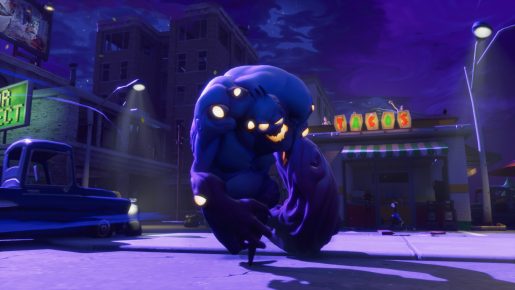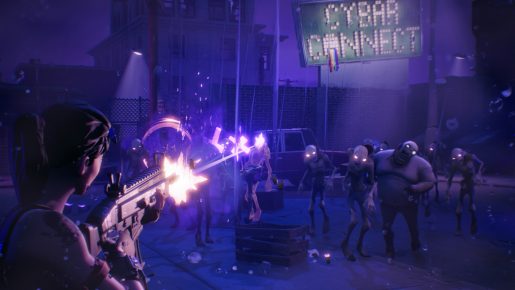Fortnite is described by People Can Fly and Epic Games as a cooperative sandbox survival game but at its core it truly is a tower defence game. The game has just entered into early access after initially being unveiled back in 2011. The game is currently available for Windows PC, macOS, PlayStation 4 and Xbox One, with a full free-to-play release expected in 2018. However, despite being in development for a long time do the zombie hordes live up to the billing or is this one zombie game too many? Let’s find out!
Straight away players are going to notice the art style, which is perfect for the type of game People Can Fly and Epic Games are portraying. It is a cartoony style that keeps things light-hearted, far away from the “realistic” gory zombies in the likes of Resident Evil or, love it or hate it, the Nazi zombies element of the Call of Duty franchise. This style is used game wide to create a distinct visual experience with nothing that seems out of place. This helps players on multiple angles with game world objects and zombies able to be distinct enough at a simple glance. This is key for players when they need to collect a specific resource and to determine the type of threat inbound.
Fortnite is rather reminiscent of the Orcs Must Die! franchise where players build floor, wall and ceiling traps to defend against waves. This similarity is far from a bad thing though. Fortnite takes these concepts and expands on them in multiple angles, resulting in a similar but better game. Firstly, players must actively (at least initially) wander the map to collect resources.
Players are always armed with a trusty, upgradable, pickaxe. Swinging it at game world objects from cars and walls to rocks and trees will see the player obtain resources of an appropriate type. As the pick hits the objects they carry on the visual cartoony style with a bit of a comical wobble, visibly becoming broken as you continue to swing. Some containers, not just loot chests, can be searched and this is where players can find special objects or even full traps.
When you have enough resources you can use them to craft. This isn’t just a case of instantly building an item and it appearing in the world. Players will need to crafting what they need before the item appears in their inventory and is able to be placed. This is clearly a conscious decision by the developers to put more emphasis on the building and planning aspects of the game. As you must enter a menu to craft a trap or weapon, it isn’t something to do when the zombie hordes are upon you and your base, even if you have covering fire from teammates. Setting up before activating the various defend points is therefore of much more importance.
Unlike Orcs Must Die! in Fortnite players can literally build a fort, not just arm pre-defined walls to the teeth. Players can build basis floors, walls, sloped stairs and roof tiles. For the first couple of games this is probably what players will stick to. Initially, this makes building look a tad limited but it all opens up with advanced editing. For instance, by customising walls players can make walls of differing heights or add a door to be able to pass through it. Players can even customise stairs to make them go up at right angles or be full stair cases rather than just slopes. These little edits combine to make a robust building system that is, past the initially fiddly-ness, easy to use.
I wouldn’t go as far as saying that any of the playing locations in Fortnite are large but for what is at its core a tower defence title they are big. I’ve not played a game from the genre with quite as much size though it is a requirement for the resource collection, and to some extent the building, side of the game. Mini-objectives such as saving survivors from parts of the map also benefit from the size. If everything was crammed on top of each other the exploring aspect to find these survivors would be pointless. This isn’t the only incentive to explore the map though as chests of loot can also be found. By making exploring important it means players will get more time out of each and every level.
Omnidirectional zombies is never something players want to defend against. In Fortnite players will have to get used to it though, as often objectives are in small expanses. It is possible via the building tools to change things, funnelling zombies down distinct paths, something necessary as players progress onto harder levels.
The first couple of hours of gameplay will effectively see players plodding through an extensive tutorial. This results in the initial levels feeling extremely easy even for novice players. The length of the tutorial is, almost unfortunately, a necessity due to the amount of outside of the action things available to players. From the glorious loot llamas and the huge skill tree to weapon schematics and saved survivors there is a lot that can be done between missions. Aside from smashing the piñata styled loot llamas, one of the most helpful parts is expeditions. Players can send a select number of AI survivors out to gather a range of items. I found this extremely useful for gaining additional materials without spending hours gathering. This speeds up the game and gets players to the construction side of things quicker. Thus, the action comes around that bit faster.
A few small additions help this game flow, aside from the expeditions feature. The best to highlight is the ability to craft ammo be holding reload. In a game where it is all about setting up a base before the zombie waves start I anticipated having to jump through menus to craft ammo. Thankfully, by simply holding R players craft the ammo type needed for the currently selected weapons. This removes one potential frustration point and while not necessarily in keeping with the prepare then face the horde mentality I believe it is the correct decision.
Being entirely honest while Ray the robot provides entertainment the storyline is far from Fortnite’s strong point. This isn’t overly surprising to anyone I’m sure but that isn’t to say it does nothing to link one objective to another. It gives an odd laugh while it gives vague reasoning behind each mission but that is about it, a link between the action. This isn’t helped by the objectives themselves. Rarely do they shakes up the core of the game. Fortnite is at the end of the day a tower defence game. They can change the objective of the defence but the gameplay will boil down to the placement of traps and mowing down the incoming horde of zombies.
It is 100% possible to play Fortnite solo but it truly gets exciting when played cooperatively. Jumping online with a group of friends is what Fortnite feels like it is built for. Fear not if none of your friends are up for zombie action as the game has built in features to help gamers play together. At any point players can switch their search options between friends only or public, enabling other gamers from around the world to join in to win the objective. This isn’t a feature for everyone but it can speed some of the early levels up nicely. At least until you have more things such as missile call downs, resource llamas and powerful traps at your disposal.
When it comes to weapons, there is a vast selection at players’ disposal, categorised into either melee or ranged weapons. There is certainly a weapon for your own unique play style. Whether you want to be a fast-moving ninja warrior wielding a badass sword cutting down foes, a Rambo wannabe with a high calibre assault rifle drowning your foes in a wall of lead, or a pinpoint accurate sniper exploding zombie heads from a mile away.
Fortnite adopts the standard RPG colour system to indicate the rarity of the all the way from common up to mythic. Weapons can be found scattered across the map in chests, created in the character’s inventory using schematics if you have materials or found when breaking llama loot boxes. The range is phenomenal and means there’s always a reason to try out a new weapon. Stopping players get stuck always utilizing a single weapon.
This variety is then extended to the range of traps players can utilize to aid their defence against the hordes. These traps are broken down into Floor, Wall and Ceiling categories, which are furthered by the rarity sub-categories. Players may start off with simple wooden floor spikes but soon they’ll have access to an arsenal of awesome traps. Some are more situational such as traps that temporarily stun zombies within range. However, they are all extremely helpful and effective at reducing the zombie count.
Unfortunately for our plucky survivors the variety offered to players has also been applied to the zombies. New zombie types are added in overtime. It’s not far into the game when players will see not only increased numbers but some which are larger in size, tankier, ranged zombies which act like mortars and others which throw exploding canisters ready to deal serious damage to your carefully constructed base. Having this variety coming at you means players will often have to dynamically change their focus, calling out to allies when certain types enter the battlefield.
Overall, Fortnite may be in Early Access but it is obvious that it is a solid base ready to be built on, if you pardon the pun. The basic elements of the game are all interlinked in a logical way, with players exploring the maps to collect resources to build up defences to defend against the horde. With different looking locations, slight changes in objectives and the great amount of variety in zombies and weaponry, Fortnite does plenty to not feel like a rinse and repeat tower defence title. There is maybe too much going on outside of the tower defence for new players. Nonetheless, it’ll certainly help the game keep players interest in the long term. Something I’m extremely grateful for as I can see myself playing Fortnite for long time to come!
[Editor’s Note: Fortnite was provided to us by the developer for review purposes. The game was reviewed on Windows PC]





